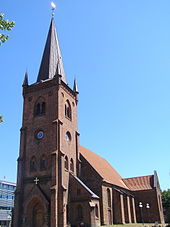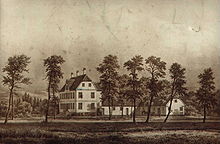
Haraldskær Woman
About this schools Wikipedia selection
This selection is made for schools by a children's charity read more. See http://www.soschildren.org/sponsor-a-child to find out about child sponsorship.
The Haraldskær Woman is an Iron Age bog body naturally preserved in a bog in Jutland, Denmark. Labourers discovered the body in 1835 while excavating peat on the Haraldskær Estate. Disputes regarding the age and identity of this well-preserved body were settled in 1977, when radiocarbon dating determined conclusively that her death occurred around 500 BC. This archaeological find was one of the earliest bog bodies discovered, the other two known being Tollund Man (Denmark) and Lindow Man (England).
The body of the Haraldskær Woman is remarkably preserved due to the anaerobic conditions and tannins of the peat bog in which she was found. Not only was the intact skeleton found, but also the skin and internal organs. Her body lies in state in an ornate glass-covered coffin, allowing viewing of the full frontal body, inside the Church of Saint Nicolai in central Vejle, Denmark.
Mistaken identity
After discovery of the body, early theories of her identity centered around the persona of the Norwegian Gunnhild Mother of Kings, who lived around 1000 AD. Most of the bog bodies recovered indicate the victim died from a violent murder or ritualistic sacrifice. These theories are consistent with the body being hurled into a bog as opposed to burial in dry earth.
The Jómsvíkinga saga tells that Queen Gunhild was murdered and then drowned in a bog, her death having been ordered by the Danish Harald Bluetooth. Based upon the belief of her royal personage, King Frederick VI of Denmark commanded an elaborate sarcophagus be carved to hold her body. This royal treatment of Haraldskær Woman’s remains explains the excellent state of conservation of the corpse; conversely, Tollund Man, a later discovery, was not properly conserved and most of the body has been lost, leaving only the head as original remains in his display.
A young 19th century archaeologist named J.J.A. Worsaae held the opposing theory, that Haraldskær Woman derived from the Iron Age. Radiocarbon testing in the year 1977 revealed Haraldskær woman died about 500 BC, and thus could not possibly be Queen Gunhild. Even though she is not now connected to any royal lineage, her body still lies in state in a display of high honour in the north nave of Saint Nicolai Church.
Details of Haraldskær Woman
The body of Haraldskær woman has the complete skin envelope intact, as well as internal organs. She is estimated to have died at the age of approximately 50. She is noted to have a lancing wound to the knee joint area, where some object (possibly a sharp branch) penetrated to some depth. Whether she was a murder victim or a ritual sacrifice is not clear. In any case, Haraldskær Woman exhibits a breathtaking state of preservation. Her skin is deeply bronzed with robust skin tone and all the body joints are preserved with overlying skin in a state as if she died a year ago, albeit slightly desiccated.
Forensic analysis was performed on Haraldskær Woman in the year 2000, revealing stomach contents of unhusked millet and blackberries. Her neck had markings as if a rope may have been applied for torture or strangulation. A determination was made that death was a form of ritual killing, as indicated by forensic data and also since cremation was the prevailing mode of interment in that age in Jutland.
Bog chemistry
There are a limited number of bogs which have existed for millennia that have the correct conditions for preservation of mammalian tissue. Most of these bogs occur in northern Europe, where approximately 700 ancient bodies have been discovered as of the year 2006. These bogs are formed in areas which lack drainage and hence have little freshwater exchange; they are also characterized by virtually completely anaerobic conditions. This environment, devoid of oxygen, denies the prevalent subsurface aerobic organisms any opportunity to initiate the tissue decay process. Modern experimenters have been able to mimic bog conditions in the laboratory and demonstrate the preservation process well, albeit over shorter time frames than the 2500 years the Haraldskær Woman's body has survived.
The bog chemistry environment involves a completely saturated acidic environment, where considerable concentrations of organic acids and aldehydes are present. Layers of sphagnum and peat assist in preserving the cadavers by enveloping the tissue in an immobilizing matrix, impeding water circulation and any oxygenation.
An additional feature of anaerobic preservation by acidic bogs is the ability to conserve hair, clothing and leather items. An excellent example of the complete scalp hair as well as clothing attire being preserved is for the Bronze Age Egtved Girl, also recovered in Jutland, Denmark.
Most of the bog bodies discovered had some aspects of decay or else were not properly conserved. When such specimens are exposed to the normal atmosphere without special conservation techniques, they may rapidly begin the decomposition process. As a result of such mishandling, many specimens have been effectively destroyed.
Relation to other bog bodies
Geographically the principal locations where bog bodies have been discovered are Denmark, northern Germany, the Netherlands (at least 65), the United Kingdom and Ireland. Many of the bodies have been recovered in the routine extraction of peat for fuel and soil amendment uses. The oldest of these bodies dates to about 8000 BC, while the majority of specimens derive from the Iron Age to Roman era (about 800 BC to 400 AD). Major excavations have occurred in Jutland following the discovery that systematic conservation of Iron Age bodies and buildings was attributable to acidic anaerobic bog habitats.
Haraldskær Woman in literature
The first literary reference to Haraldskær Woman was in the 1845 work of Danish playwright Jens Christian Hostrup. This dramatic work, The Sparrow and the Crane Dance, portrays Queen Gunhild as a mysterious ghostly personage who materializes before a tailor to present him with a magical ring. The gift alters the way people perceive the beneficiary and transforms him into a heroic figure. The play ridicules the bourgeoisie's inability to engage the realities of the mid-nineteenth century, and the work indirectly discredits the theory that the Haraldskær Woman was actually Queen Gunhild, thus becoming the first major public endorsement of Worsaae’s hypothesis.



